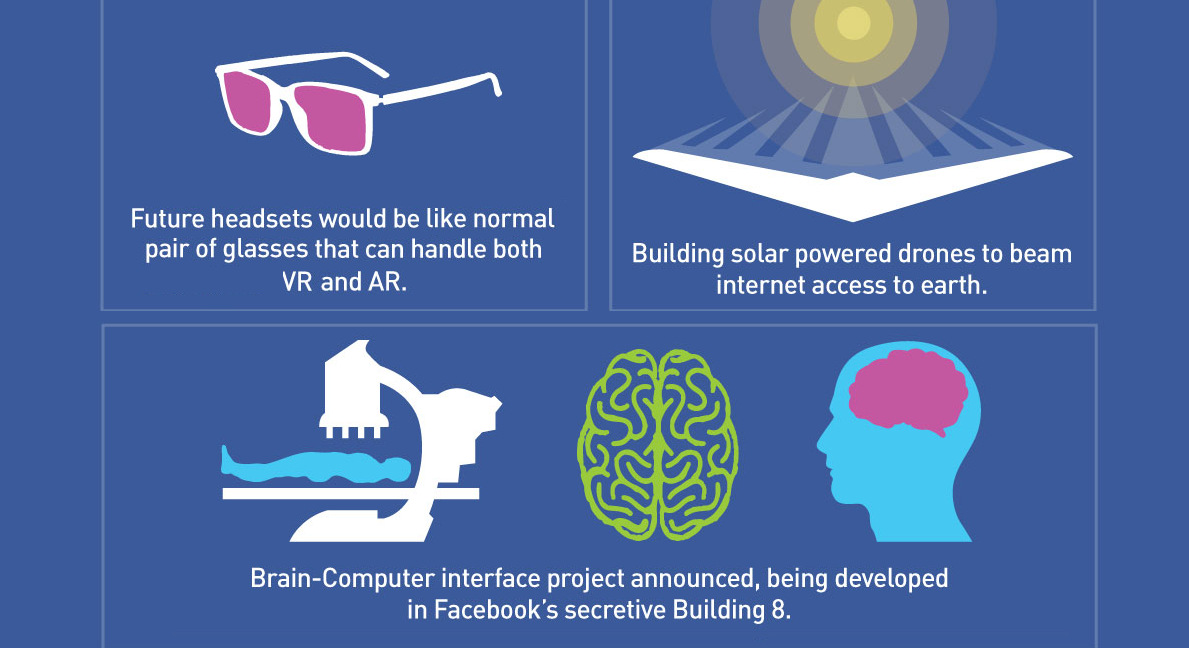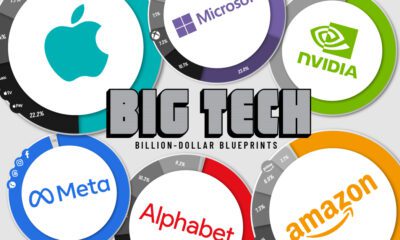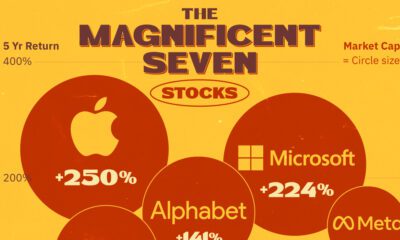Technology
The Progress of Facebook’s 10-Year Masterplan

The Details of Facebook’s 10-Year Masterplan
In the company’s first 10 years, Mark Zuckerberg transformed Facebook from a college side-project into a multi-billion dollar platform.
Along the way, Zuckerberg was given many opportunities to exit. He was offered $75 million from Viacom in the very early days, and then $1.5 billion later on (including $800 million cash up front). Yahoo also missed out on making a deal after having its $1 billion offer rejected in 2006.
Zucks kept to his guns, even despite significant pressure to sell. As Peter Thiel recounts, Zuckerberg didn’t know what he’d do with the money, and would likely just start another social networking site anyways.
Given his vision for Facebook and an obvious passion for connecting people, it’s not surprising to learn that over the next 10 years, Zuckerberg plans to execute just as ambitiously.
Facebook’s Masterplan
Today’s infographic comes from Futurism, and it details Facebook’s masterplan to potentially make the company a $1 trillion colossus. It’s worth noting that Facebook is technically already about one year into the 10-year plan, and that the infographic has been updated to include the latest developments in the company as of 2017.
Here are the ambitious plans that the company hopes to bring to a reality:
- Use solar-powered drones to beam internet access to Earth.
- Build hardware that will boost internet connectivity in dense urban areas.
- Launch a satellite to help provide internet access to Africa.
- Enable artificial intelligence to learn about content. (ie. what a video or image is all about.)
- Train neural networks through Facebook’s open source Torch system.
- Build VR/AR headsets that look like a normal pair of glasses.
- Work on new social experiences using virtual reality as a social platform.
- Continued development of the Brain-Computer interface project to allow users to “type” with their thoughts.
The latter of these plans was just announced just last week, and it involves a team of 60 engineers working to find a way to translate your thoughts into Facebook updates.
Using non-invasive optical imaging to scan your brain a hundred times per second, eventually the goal is to allow people to “type” at 100 words per minute, a 5x increase over normal phone typing speeds.
Technology
Visualizing AI Patents by Country
See which countries have been granted the most AI patents each year, from 2012 to 2022.

Visualizing AI Patents by Country
This was originally posted on our Voronoi app. Download the app for free on iOS or Android and discover incredible data-driven charts from a variety of trusted sources.
This infographic shows the number of AI-related patents granted each year from 2010 to 2022 (latest data available). These figures come from the Center for Security and Emerging Technology (CSET), accessed via Stanford University’s 2024 AI Index Report.
From this data, we can see that China first overtook the U.S. in 2013. Since then, the country has seen enormous growth in the number of AI patents granted each year.
| Year | China | EU and UK | U.S. | RoW | Global Total |
|---|---|---|---|---|---|
| 2010 | 307 | 137 | 984 | 571 | 1,999 |
| 2011 | 516 | 129 | 980 | 581 | 2,206 |
| 2012 | 926 | 112 | 950 | 660 | 2,648 |
| 2013 | 1,035 | 91 | 970 | 627 | 2,723 |
| 2014 | 1,278 | 97 | 1,078 | 667 | 3,120 |
| 2015 | 1,721 | 110 | 1,135 | 539 | 3,505 |
| 2016 | 1,621 | 128 | 1,298 | 714 | 3,761 |
| 2017 | 2,428 | 144 | 1,489 | 1,075 | 5,136 |
| 2018 | 4,741 | 155 | 1,674 | 1,574 | 8,144 |
| 2019 | 9,530 | 322 | 3,211 | 2,720 | 15,783 |
| 2020 | 13,071 | 406 | 5,441 | 4,455 | 23,373 |
| 2021 | 21,907 | 623 | 8,219 | 7,519 | 38,268 |
| 2022 | 35,315 | 1,173 | 12,077 | 13,699 | 62,264 |
In 2022, China was granted more patents than every other country combined.
While this suggests that the country is very active in researching the field of artificial intelligence, it doesn’t necessarily mean that China is the farthest in terms of capability.
Key Facts About AI Patents
According to CSET, AI patents relate to mathematical relationships and algorithms, which are considered abstract ideas under patent law. They can also have different meaning, depending on where they are filed.
In the U.S., AI patenting is concentrated amongst large companies including IBM, Microsoft, and Google. On the other hand, AI patenting in China is more distributed across government organizations, universities, and tech firms (e.g. Tencent).
In terms of focus area, China’s patents are typically related to computer vision, a field of AI that enables computers and systems to interpret visual data and inputs. Meanwhile America’s efforts are more evenly distributed across research fields.
Learn More About AI From Visual Capitalist
If you want to see more data visualizations on artificial intelligence, check out this graphic that shows which job departments will be impacted by AI the most.
-

 Markets1 week ago
Markets1 week agoU.S. Debt Interest Payments Reach $1 Trillion
-

 Business2 weeks ago
Business2 weeks agoCharted: Big Four Market Share by S&P 500 Audits
-

 Real Estate2 weeks ago
Real Estate2 weeks agoRanked: The Most Valuable Housing Markets in America
-

 Money2 weeks ago
Money2 weeks agoWhich States Have the Highest Minimum Wage in America?
-

 AI2 weeks ago
AI2 weeks agoRanked: Semiconductor Companies by Industry Revenue Share
-

 Markets2 weeks ago
Markets2 weeks agoRanked: The World’s Top Flight Routes, by Revenue
-

 Demographics2 weeks ago
Demographics2 weeks agoPopulation Projections: The World’s 6 Largest Countries in 2075
-

 Markets2 weeks ago
Markets2 weeks agoThe Top 10 States by Real GDP Growth in 2023















